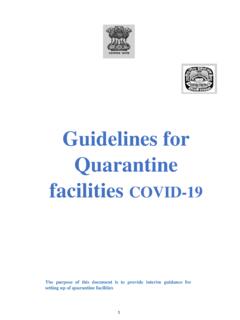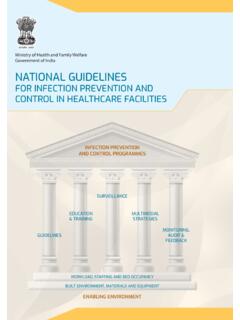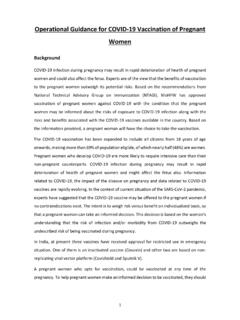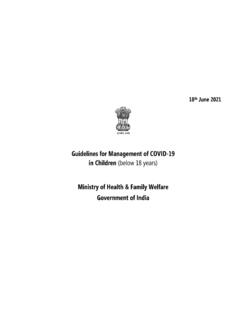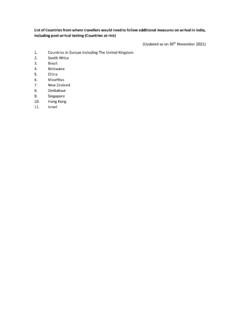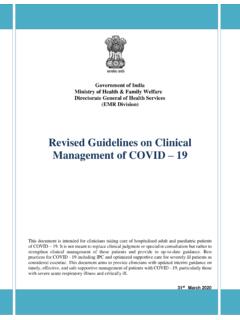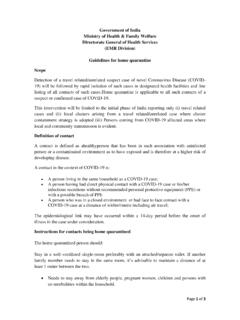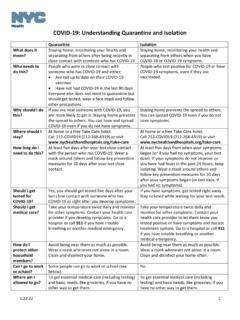Transcription of 5 January 2022 Government of India Ministry of Health
1 Page 1 of 7 5th January 2022 Government of India Ministry of Health & Family Welfare Revised guidelines for home Isolation of mild /asymptomatic COVID-19 cases 1. Background Over the past two years, it has been seen globally as well as in India that majority of cases of COVID-19 are either asymptomatic or have very mild symptoms. Such cases usually recover with minimal interventions and accordingly may be managed at home under proper medical guidance and monitoring. Ministry of Health & FW has thus issued and updated guidelines for home isolation from time to time to clarify selection criteria, precautions that need to be followed by such patients and their families, signs that require monitoring and prompt reporting to Health facilities.
2 The present guidelines are applicable to COVID-19 patients who have been clinically assessed and assigned as mild /asymptomatic cases of COVID-19. 2. Asymptomatic cases; mild cases of COVID-19 The asymptomatic cases are laboratory confirmed cases who are not experiencing any symptoms and have oxygen saturation at room air of more than 93%. Clinically assigned mild cases are patients with upper respiratory tract symptoms with or without fever, without shortness of breath and having oxygen saturation at room air of more than 93%. 3. Patients eligible for home isolation i. The patient should be clinically assigned as mild/ asymptomatic case by the treating Medical Officer.
3 Further a designated control room contact number at the district /sub district level shall be provided to the family to get suitable guidance for undertaking testing, clinical management related guidance, assignment of a hospital bed, if warranted. ii. Such cases should have the requisite facility at their residence for self-isolation and for quarantining the family contacts. iii. A caregiver (ideally someone who has completed his COVID-19 vaccination schedule) should be available to provide care on 24 x7 basis. A communication link between the Page 2 of 7 caregiver and a Medical Officer is a prerequisite for the entire duration of home isolation.
4 Iv. Elderly patients aged more than 60 years and those with co-morbid conditions such as Hypertension, Diabetes, Heart disease, Chronic lung/liver/ kidney disease, Cerebro-vascular disease etc shall only be allowed home isolation after proper evaluation by the treating medical officer. v. Patients suffering from immune compromised status (HIV, Transplant recipients, Cancer therapy etc.) are not recommended for home isolation and shall only be allowed home isolation after proper evaluation by the treating Medical Officer. vi. While a patient is allowed home isolation, all other members in the family including other contacts shall follow the home quarantine guidelines available at: 4.
5 Instructions for the patient i. Patient must isolate himself from other household members, stay in the identified room and away from other people in home , especially elderly and those with co-morbid conditions like hypertension, cardiovascular disease, renal disease etc. ii. The patient should stay in a well-ventilated room with cross ventilation and windows should be kept open to allow fresh air to come in. iii. Patient should at all times use triple layer medical mask. They should discard mask after 8 hours of use or earlier if the mask becomes wet or is visibly soiled. In the event of Caregiver entering the room, both Caregiver and patient may preferably consider using N-95 mask.
6 Iv. Mask should be discarded after cutting them to pieces and putting in a paper bag for a minimum of 72 hours. v. Patient must take rest and drink lot of fluids to maintain adequate hydration. vi. Follow respiratory etiquettes at all times. vii. Undertake frequent hand washing with soap and water for at least 40 seconds or clean with alcohol-based sanitizer. viii. The patients shall not share personal items including utensils with other people in the household. ix. Need to ensure cleaning of frequently touched surfaces in the room (tabletops, doorknobs, handles, etc.) with soap/detergent & water.
7 The cleaning can be undertaken either by the patient or the caregiver duly following required precautions such as use of masks and gloves. x. Self-monitoring of blood oxygen saturation with a pulse oximeter for the patient is advised. xi. The patient shall self-monitor his/her Health with daily temperature monitoring (as given below) and report promptly if any deterioration of symptom is noticed. The status shall be shared with the treating Medical Officer as well as surveillance teams/Control room. Page 3 of 7 Patients Self - Health monitoring Chart Date and time Temperature Heart rate (from pulse oximeter) SpO2 % (from pulse oximeter) * Feeling: (better /same /worse) Breathing: (better / same/ worse) ** *For self-monitoring blood oxygen saturation with a pulse oximeter, place the index finger (after cleaning hands and removing nail polish, if any) in the pulse oximeter probe and take the highest steady reading after a few seconds.
8 **The patient may self-monitor breathing rate/respiratory rate in sitting position, breathe normally and count the number of breaths taken in 1 full minute. 5. Instructions for Care Giver i. Mask: o The caregiver should wear a triple layer medical mask. N95 mask may be considered when in the same room with the ill person. o Front portion of the mask should not be touched or handled during use. o If the mask gets wet or dirty with secretions, it must be changed immediately. o Mask should be discarded after cutting them to pieces and putting in a paper bag for a minimum of 72 hours. o Perform hand hygiene after disposal of the mask.
9 O He/she should avoid touching own face, nose or mouth. ii. Hand hygiene o Hand hygiene must be ensured following contact with ill person or his immediate environment. o Use soap and water for hand washing at least for 40 seconds. Alcohol-based hand rub can be used, if hands are not visibly soiled. o After using soap and water, use of disposable paper towels to dry hands is desirable. If not available, use dedicated clean cloth towels and replace them when they become wet. o Perform hand hygiene before and after removing gloves. iii. Exposure to patient/patient s environment o Avoid direct contact with body fluids (respiratory, oral secretions including saliva) of the patient.
10 Use disposable gloves while handling the patient. Page 4 of 7 o Avoid exposure to potentially contaminated items in his immediate environment ( avoid sharing eating utensils, dishes, drinks, used towels or bed linen). o Food must be provided to the patient in his room. Utensils and dishes used by the patient should be cleaned with soap/detergent and water while wearing gloves. The utensils may be re-used after proper cleaning. o Clean hands after taking off gloves or handling used items. Use triple layer medical mask and disposable gloves while cleaning or handling surfaces, clothing or linen used by the patient.
